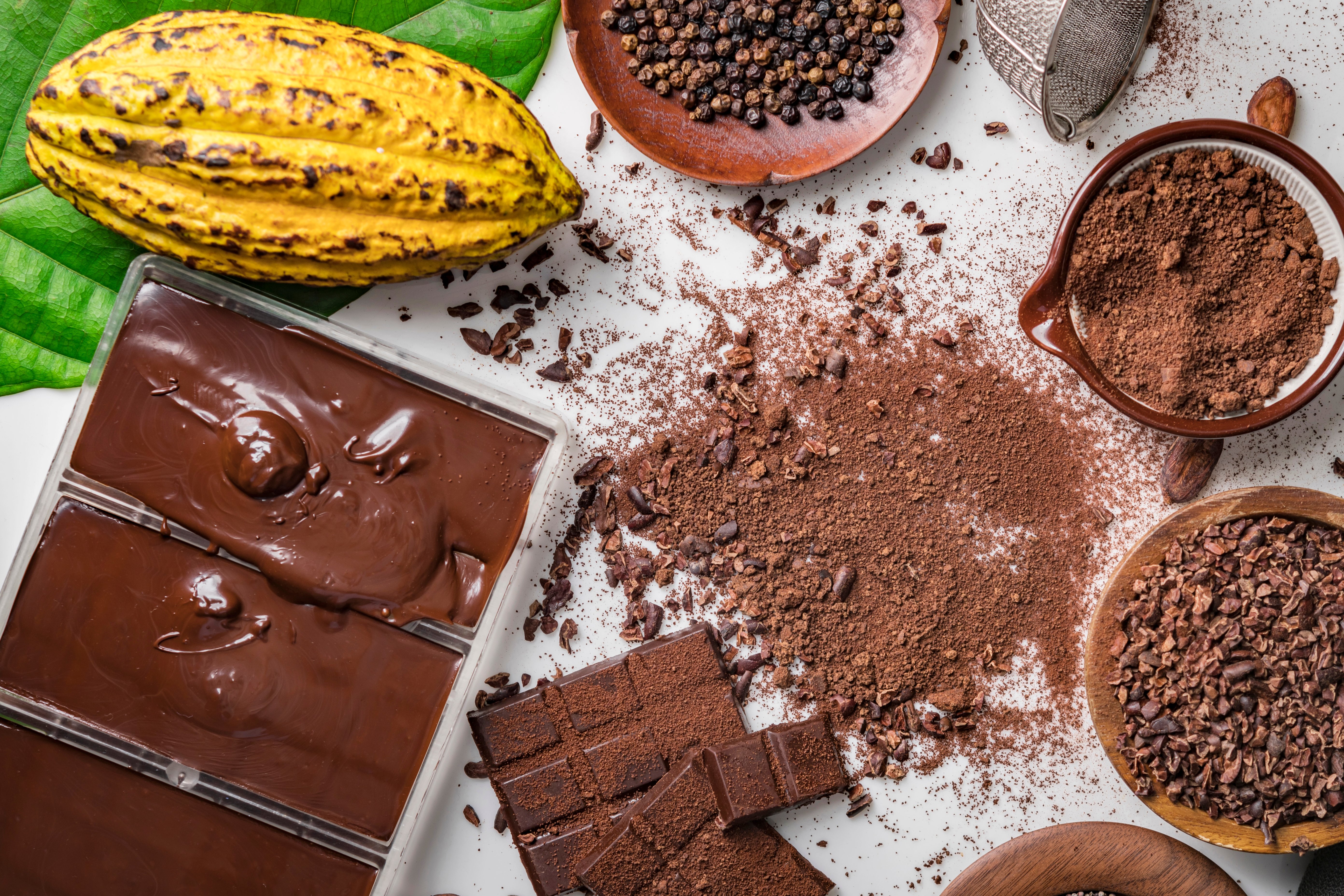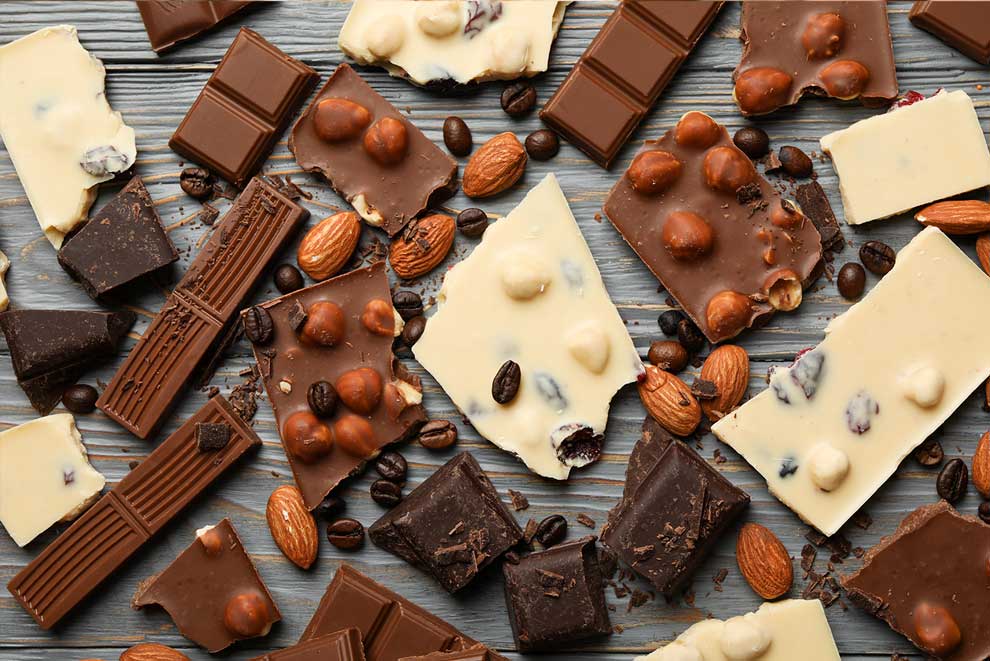Know Your Chocolate: Making Chocolate from Cacao Beans

Chocolate is a food loved by many, yet not everyone knows how this flavorful, melt-in-the-mouth delicacy is produced. One may even wonder how a hard and bitter cacao bean can be processed into the chocolate we know. In this article, we will cover the process of making chocolate from cacao beans.
The chocolate-making process consists of three stages:
- Cacao pods processing, which takes place in the cacao plantation
- Cacao beans processing, where the cacao beans are processed into intermediate products in the factory
- Chocolate processing, where intermediate products are made into the final chocolate product.
Cacao Pods Processing
1. Harvesting
Cacao pods reach maturity 5-6 months after fertilization, and can be harvested when they are yellow. Harvesting of cocoa pods must be done manually by farmers so as not to damage the trees.
2. Sortation
The harvested cacao pods are opened to reveal the cacao beans which are covered in a white fibrous pulp. One cocoa pod can contain 35-50 cacao beans. The beans are then stacked on a mat, banana leaf or in a box and covered.
3. Fermentation
In the fermentation process, bacteria and yeast in the air cause the chemical components in the pulp to change into alcohol and acetic acid. This is one of the most important stages in the first stage of cocoa pod processing, because this is where the flavor formation of cocoa begins. In this process, heat will also be generated which can prevent the growth of cacao beans. Periodically, farmers will turn the pile of beans slowly so that the process occurs evenly. The fermentation process can take as long as 5 to 8 days.
4. Drying
Before they are shipped to the chocolate factory, cacao beans need to go through a drying process. The beans are spread on a tray and dried in the sun for about a week.
5. Bean sortation
After drying, the moisture content in the cacao beans is reduced to 6-7% and the weight is reduced by almost half. The beans are then sorted by size and quality, and packaged for shipping to the mill.
Cacao Beans Processing
1. Testing and cleaning
When the cacao beans reach the factory, they first need to be tested in the laboratory. In addition to checking the size, quality, moisture content, and the presence of mold or other defects, a sensory test is also carried out to check their taste and aroma. After the test is complete, the cocoa beans are cleaned of foreign objects such as stones, twigs, metal, dust, etc.
2. Breaking and winnowing
The cacao beans are cracked and the shell and nibs are then separated through a process called winnowing. During the winnowing process, a gust of wind separates the cacao nibs from the shell.
3. Roasting
Roasting is an important step in cocoa processing, as it not only forms the flavor, aroma, and color in cacao nibs but also reduces water content and kills the microorganisms present. There are two roasting methods commonly used, namely bean roasting and nib roasting. In the roasting process, alkaline compounds are often added to get the desired color and taste in a process called alkalization.
4. Grinding
After the roasting process, the cacao nibs are then ground to obtain a liquid paste called cocoa liquor or cocoa mass.
5. Pressing and pulverizing
The cocoa mass goes through a pressing process to obtain cocoa butter and cocoa cake. The solid cocoa cake then goes through a pulverizing process to produce cocoa powder. These semi-finished products are the raw materials for making chocolate.
Are you on LinkedIn? Do you want to get the latest news and update on chocolate in the confectionery, industrial bakery and ice cream industry?
Chocolate Processing
1. Mixing
The chocolate processing process begins with the mixing process. Raw materials such as sugar, cocoa mass, cocoa powder, cocoa butter or vegetable fat, milk powder, and other ingredients are combined in a mixer to obtain a suitable paste mixture for the next process, namely the refining process. The composition in the mixing process is adjusted to the product to be manufactured. For example, to produce milk chocolate, milk powder and vanilla extract are added.
2. Refining
In the refining process, the paste from the mixer is then passed through a conveyor belt to a five-roll machine. This process aims to smoothen the chocolate ingredients so that the particle size is approximately below 40 microns. The result is chocolate that has a soft mouthfeel.
3. Conching
Conching is a combination of stirring, heating and aeration processes, which aims to produce the desired flavor. This process also removes unwanted flavors and reduces the water content. By the end of the process, the chocolate will have a really smooth texture. This process can take several hours.
4. Tempering and packaging
Tempering is a process that aims to form fat crystals (beta or 𝛃 crystals) in cocoa butter. It is a stable type of fat crystal that enables chocolate to have its signature characteristics: glossy, snaps when broken, and does not easily melt at room temperature but melts in the mouth. The method commonly used for the tempering process is to heat the chocolate to ensure there are no residual fat crystals, and then cooled to a certain temperature to perfectly form the beta crystals.
After being tempered, the chocolate then goes through a printing and packaging process, or is further processed into other products such as chocolate candy.
The process of making chocolate is a series of long and complex processes. Manufacturing it requires expertise as well as the right tools and technology to produce the best quality chocolate. At PT Freyabadi Indotama, we have been producing chocolate for more than 25 years. Equipped with three factories in Indonesia and Thailand with a high production capacity and an experienced R&D team, we have assisted various confectionery, ice cream, industrial bakery and quick service restaurant (QSR) industry players in the Asia Pacific, Middle East and Africa.
If you need a customized or a large quantity of chocolate product, you can contact us by clicking the button below. Our consultants will be happy to assist you.



